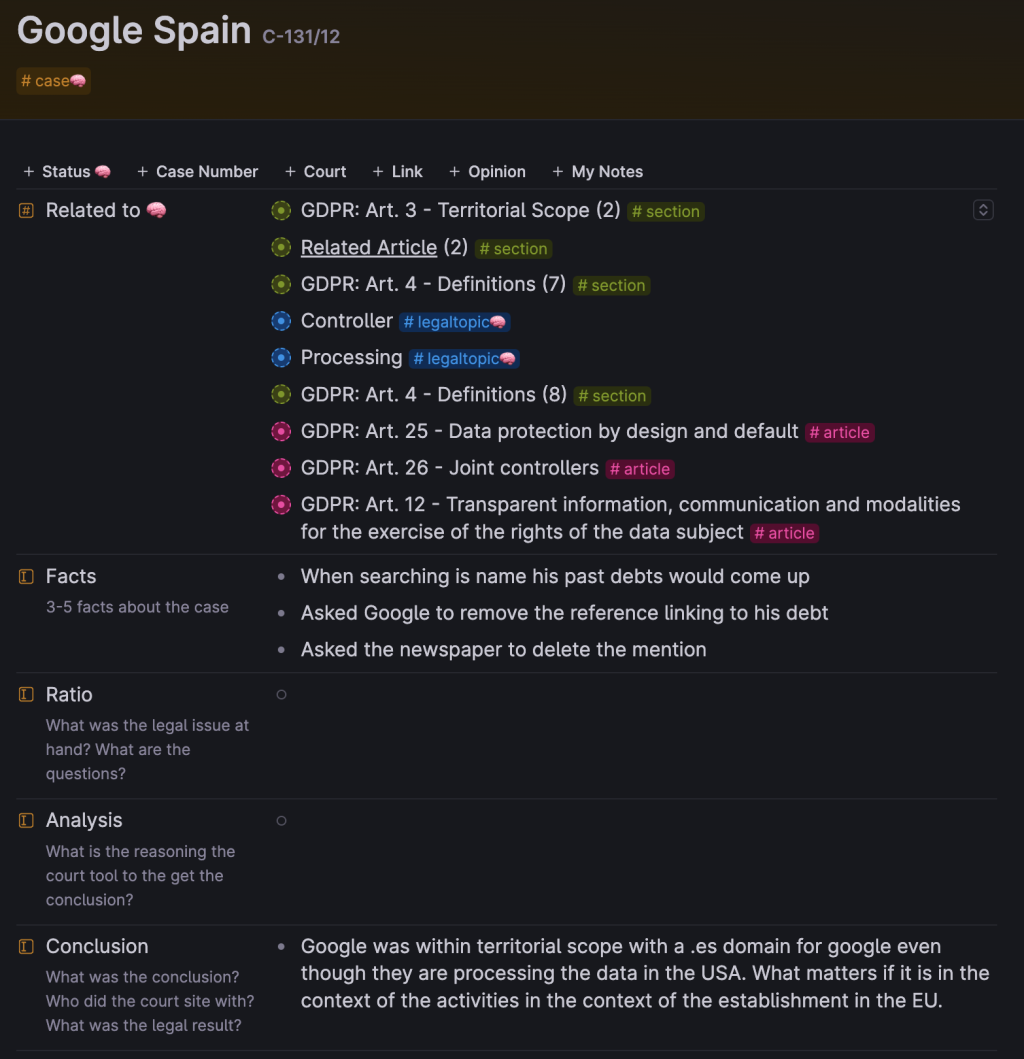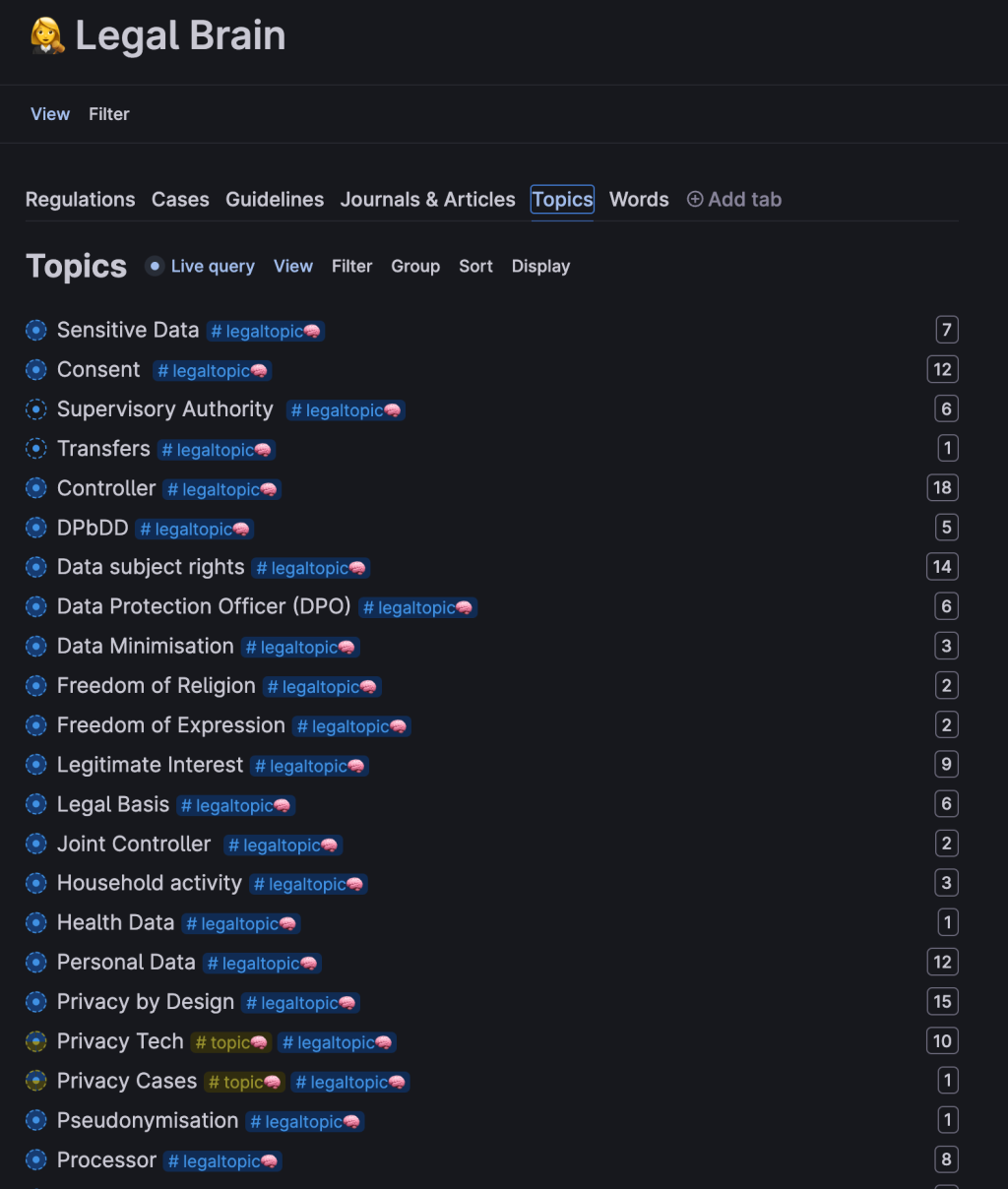Going back to school while working full time forces you to be very stingy with your time. You rely on processes, consistency, and systems you create for yourself to make it through.
Starting my LLM (no I never went to law school before this) has pushed me to the edge in terms of time and new learnings. I'm needing to retain things I never thought I would care to. So I created a system to organise, as best I can, my cases, notes, laws, regulations, and articles. To create a "Legal Brain" that I can reference as I write case notes, papers, and start working on my thesis.
Whenever I mention this most imagine that I have this mega spreadsheet or Airtable with all my cases listed and tagged.
I tried that in Week 1. Wasn't going to work for me.
You see, the point is not to have a list of cases.
The point is not to have all the directives, regulations, proposals, opinions, and guidelines in one place.
The point is that you can easily reference whichever case, guideline, opinion, article, etc is appropriate to whatever you are researching or questioning.
That can't be done with a list.
A list doesn't help you make connections. It just list things you usually need to know about to find.
So I create my system. My Legal Brain.
It's quite simple once you think about it but life changing once implemented.
The main idea is to allow yourself to find anything that is related to anything within the "brain" or network. Everything should be and is connected and it should be open to receiving more connections as they are made.
To allow these connection to occur I need the ability to be able to find things by case, topic, regulation, etc.
To allow for this to work I need a solid structure of tags and queries.
The Basics
(note: I use Tana to do this and it is heavily inspired by the SN(A)CK system created for Tana by Theo Køppen)
I use a few supertags which I extend as needed. (A super tag is a tag that can have others nested below it. Those below reference the above tag but can have their own unique parameters as well)
Each of the tags has a set of fields to help me condense my thoughts. Fields range from simple "date decided" to "case summary".
Queries are build around these tags and fields to allow me to find connections and clusters of information. It's what allows me to see connections, generate ideas, and build relationships.
The workflow
My workflow, let's say during a lecture, would look something like this.
Take notes (#lecturenote) and as a case is mentioned tag it #case.
As a questions arises that I want to ask later tag it #question.
Any note of interest that I want to be able to refer back to easily is tagged #note.
Any legal act of sorts is tagged either #regulation, #directive, etc. which are all an extension of a supertag called #legal-instrument.
Each of the above tags have one mandatory field that ties it all together called "related to". It acts as the connector.
The topics, along with the cases, regulations, articles, etc are all kept in my Legal Brain.
Once all the information is there I can explore any cluster.
Let's say I am writing on Legitimate Interest, I would look into that topic within my notes and see all related cases, notes, articles, etc to have a starting point to reference. If that is not enough I can happily go down the rabbit hole of related cases to the cases mentioned, related topics to those mentioned, or related articles to those mentioned.
This is not limited to topics but can be done for all. i.e I can go to a case a see all related cases and articles. I can go to an article of the GDPR and fine all related cases and notes. Etc.
In short, everything is connected and as long as I allow myself to explore I can find those relationships and create more as I dig deeper.
I let my brain go down rabbit holes to explore the connections and relationships that may, or may not, be relevant.
This system has created a way for me to more consistently be able to find those relationships and connections.
Closing Note
My Legal Brain, like my own, is alive. It's changing all the time. It get's adjusted. It allows for fluidity.
The moment I let it die and don't maintain it it looses it's usefulness. It's not designed to be just another list of things I might, but will never, reference.


